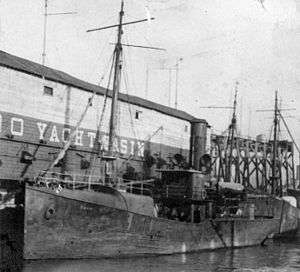USS Foam (ID-2496)
USS Foam (ID-2496) was a United States Navy trawler which served as a minesweeper and was in commission from 1918 to 1919.

 Foam prior to her U.S. Navy service, probably in the Tebo Yacht Basin at New York City. This photograph probably was taken on 11 March 1918 when Foam was inspected by the 3rd Naval District for possible U.S. Navy acquisition. | |
| History | |
|---|---|
| Name: | USS Foam |
| Namesake: | Previous name retained |
| Builder: | Fore River Shipbuilding Company, Quincy, Massachusetts |
| Completed: | 1910 |
| Acquired: | 29 May 1918 |
| Commissioned: | 1 June 1918[1] |
| Fate: | Returned to owner 3 March 1919 |
| Notes: | Served as civilian fishing trawler Foam 1910–1917 |
| General characteristics | |
| Type: | Naval trawler (minesweeper) |
| Tonnage: | 244 gross tons |
| Sail plan: | Steam engine |
Foam was built as a civilian fishing trawler in 1910 by the Fore River Shipbuilding Company at Quincy, Massachusetts. In 1917, the Russian Empire purchased Foam and the trawlers Ripple and Spray from the Bay State Fishing Company of Boston, Massachusetts, intending to place them in Imperial Russian Navy service during World War I, but the outbreak of the Russian Revolution that year prevented the three ships from leaving the United States.
The U.S. Navy's 3rd Naval District inspected Foam on 11 March 1918 for possible service. On 29 May 1918, the U.S. Navy chartered all three ships from the Russian Government for World War I use. Foam was assigned Identification Number (Id. No.) 2496, placed under the control of the Commandant, 3rd Naval District, and commissioned[2] on 1 June 1918 as USS Foam (ID-2496).
Foam operated in the 3rd Naval District for the remainder of World War I and into the months immediately following the end of the war, engaged in minesweeping duties off of New York City.
Foam was decommissioned in 1919 and returned to the Russian government on 3 March 1919.
Notes
- The Dictionary of American Naval Fighting Ships (at http://www.history.navy.mil/danfs/f3/foam.htm) claims Foam served in a non-commissioned status, but later research reflected at the Navy History and Heritage Command Online Library of Selected Images (at http://www.history.navy.mil/photos/sh-civil/civsh-f/foam.htm) establishes that she was commissioned.
- The Dictionary of American Naval Fighting Ships (at http://www.history.navy.mil/danfs/f3/foam.htm) claims Foam served in a non-commissioned status, but later research reflected at the Navy History and Heritage Command Online Library of Selected Images (at http://www.history.navy.mil/photos/sh-civil/civsh-f/foam.htm) establishes that she was commissioned.
References
- This article incorporates text from the public domain Dictionary of American Naval Fighting Ships. The entry can be found here.
- Navy History and Heritage Command Online Library of Selected Images: Civilian Ships: Foam (American Steam Trawler, 1910). Served as USS Foam (ID # 2496) in 1918–1919
- NavSource Online: Section Patrol Craft Photo Archive Foam (ID 2496)